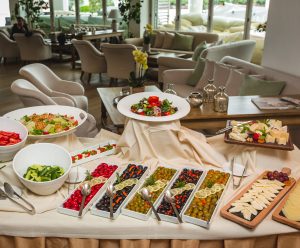When individuals gather for events — whether it’s a grand wedding, a corporate function, or a cozy get-together — the culinary offerings often steal the spotlight. However, the reality is that attendees don’t solely remember the flavour of the dishes; they also recall their visual appeal, texture, and the manner in which they were served. In the world of catering, how food is presented transcends mere decoration; it becomes an integral part of storytelling.
The arrangement, garnishing, and overall presentation of dishes convey messages about quality, inventiveness, and attention to detail. Exquisitely arranged food can evoke enthusiasm even before the first bite is taken, setting an inviting atmosphere and enriching the overall experience for guests.
This article delves into the crucial role of food presentation in catering, examining its impact on perception and the various techniques employed by caterers to elevate standard meals into remarkable highlights of any event.
1. Understanding the Psychology Behind Food Presentation
The adage “we eat with our eyes first” holds a significant truth. Research indicates that the way food is visually presented can greatly affect how we perceive its taste. A dish that is beautifully arranged can be rated as more flavourful than one that is simply plated.
- Color Psychology: Brightly colored vegetables and garnishes convey freshness and nutritional value.
- Symmetry and Balance: Harmoniously arranged plates are inherently more appealing and create a sense of appetite.
- Texture Contrast: The juxtaposition of crispy garnishes against smooth sauces engages the palate and enhances interest.
In catering environments where numerous plates are served, maintaining consistent presentation builds trust and elevates the overall prestige of the event.
2. The Impact of First Impressions
At any gathering, food displays are often the initial visual encounter for guests. An eye-catching buffet, hors d’oeuvres station, or dessert table can immediately draw attention.
- Appetizer Trays: Arranging bite-sized delicacies in artistic patterns incites curiosity.
- Buffet Setups: Multi-tiered displays, creatively designed platters, and strategic lighting transform the food spread into a focal point.
- Dessert Tables: From pastel macarons to intricately crafted chocolate sculptures, desserts can serve as stunning decorative elements.
Impressive food presentation not only showcases the hosts’ meticulousness but also makes guests feel appreciated.
3. Presentation as a Reflection of Brand Identity and Event Theme
Food presentation serves as a form of branding in catering. For corporate functions, it communicates professionalism; for weddings, it expresses the couple’s unique style; and for cultural festivals, it pays homage to heritage.
- Corporate Catering: Clean, minimalist plating embodies efficiency and innovation.
- Weddings: Romantic embellishments like floral accents or personalized desserts enhance the menu’s sentimental value.
- Cultural Events: Traditional serving methods and authentic dish arrangements celebrate cultural heritage.
Through these presentations, culinary offerings become an extension of the event’s narrative.
4. Techniques to Enhance Presentation
a) Plating Styles
- Classic Plating: Neat and symmetrical arrangements create a timeless look.
- Rustic Charm: Utilizing wooden boards and mason jars evokes a homely feel.
- Avant-Garde: Deconstructed dishes with smoke effects or edible flowers push creative boundaries.
b) Color and Contrast
- Incorporating seasonal fruits and vegetables introduces vibrant colors.
- Playing with light and dark contrasts adds visual depth.
c) Garnishes and Details
- Microgreens, citrus twists, and chocolate shavings contribute subtle elegance.
- Artistic drizzles of sauces can create dynamic movement on the plate.
d) Unique Serving Vessels
- Mini skillets, bamboo cones, or glass jars offer a novel dining experience.
- Large communal platters promote sharing and connection among guests.
These techniques transform each dish into a visual masterpiece.
5. Fostering Guest Engagement Through Interactive Presentation
Food presentation can also engage guests interactively, making them part of the culinary journey.
- Live Cooking Stations: Watching chefs flambé or craft sushi is both entertaining and appetizing.
- Build-Your-Own Bars: Allowing guests to customize their plates adds an element of fun.
- Artistic Displays: Ice sculptures or chocolate fountains not only serve as food but also become attractions themselves.
By involving guests visually and experientially, catering creates memorable moments that last long after the event ends.
6. Embracing Technology in Food Presentation
Modern catering embraces technological advancements to enrich food presentation.
- Projection Mapping: Animated visuals can transform cakes into captivating storytelling pieces.
- QR Codes on Menus: Guests can scan codes to learn about dish origins or ingredient stories.
- 3D Printing: Innovative caterers explore printed chocolate designs or sugar sculptures for
7. Cultural Influences on Presentation
Different cultures view food presentation uniquely.
- Japanese catering: Minimalism and precision, showcasing natural beauty.
- Indian catering: Abundance, rich colors, and intricate arrangements symbolize prosperity.
- Mediterranean catering: Emphasis on freshness, rustic charm, and communal platters.
Understanding cultural expectations ensures presentation feels authentic and respectful.
8. Sustainability and Presentation
Eco-conscious clients now expect beauty without waste. Caterers are rethinking presentation to align with sustainability.
- Edible containers: Bread bowls, cucumber cups, or chocolate shells.
- Reusable décor: Wooden boards, metal cutlery, and cloth napkins instead of disposables.
- Minimal-waste plating: Designing portions to reduce excess.
This approach enhances guest experience while aligning with modern values.
9. Challenges in Maintaining Presentation at Scale
Large events pose unique challenges. Ensuring every plate looks perfect for 200+ guests requires precision and coordination.
- Consistency: Training staff to replicate plating styles.
- Timing: Serving quickly without compromising beauty.
- Logistics: Transporting delicate arrangements safely.
Overcoming these challenges shows a caterer’s professionalism and skill.
10. Lasting Impressions Through Presentation
When the event is over, guests often remember standout visuals:
- The dramatic dessert tower.
- The elegant plating of the main course.
- The creativity of interactive food stations.
These visual memories become part of the event’s legacy, often shared in photos and social media posts.
Conclusion: Presentation as the Final Ingredient
In catering, presentation isn’t an afterthought—it’s the ingredient that ties taste, ambiance, and hospitality together. While flavour wins over the palate, presentation captivates the eyes, builds anticipation, and elevates food into an experience worth remembering.
For caterers, mastering food presentation is mastering the art of guest satisfaction. It’s the difference between simply serving meals and creating moments guests will talk about long after the event ends.






